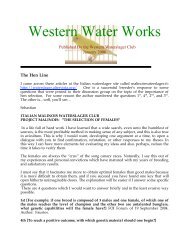Newsletter 8-09.pdf - Western Waterslager Club
Newsletter 8-09.pdf - Western Waterslager Club
Newsletter 8-09.pdf - Western Waterslager Club
You also want an ePaper? Increase the reach of your titles
YUMPU automatically turns print PDFs into web optimized ePapers that Google loves.
• Adjustments were made to their food program. During the molt they required, and were fed, arich diet, which if continued at this time would push them. This is not desirable, so changes weremade. These consisted of a reduction in the quantity of their egg food, Canary Seed, groats,green food, and Niger, while at the same time increasing the Canola Rape Seed, and continuingwith sprouted Rape. Although reduced, their diet has been kept reasonably balanced to ensurethat their weight is being maintained. This was determined by a periodic examination of all birds,to look for a thin layer of fat on their tummies. If they were not in this condition, the food wouldhave been adjusted up slightly, to increase the nourishment and vitamins. They must be healthyto sing well and to withstand being caged up so long during the shipping and showing periods.• Having described the present situation as I outlined it, I will now move on to the next step whichinvolves various pieces of canary equipment. It is an ideal time to get started with the annualtasks involved in the bird room, while the school is in session.Ready the Equipment: I am going to describe my equipment and my process of getting themready. They consisted of five-team training cabinet, show cabinets, shipping cabinets andtraining/show cages. The equipment must be thoroughly cleaned and given anti-mitetreatment. It takes a while, but it is essential that this be done. My procedures follow:• The show cages are individually inspected for any required repairs, and were then repairedand cleaned.• The glass water and seed feeder cups were removed and put into a pail of hot soapy waterfor thorough cleansing.• The trays and perches were removed, scraped clean, and put into another pail of hotsoapy water to soak.For insect control I used a 5-gallon can, which was roughly 1Ox1Ox16 inches, filled ¾ fullwith kerosene (coal oil). Using a hook made from a wire coat hanger, I suspended each cageinto the liquid, leaving it to soak for about 3 minutes. They absorbed the kerosene well, asthe cages were made with <strong>Western</strong> Red Cedar, a very absorbent wood. Following this theywere left out in the open air for several days to allow all the excess to dry off. This treatmentkept them free of red mites, and it had no adverse effect on the birds.• The glass cups were scrubbed and rinsed; the trays were brushed clean and both weredried. They and the perches were then returned to the cages.• The training, show, and shipping cabinets were cleansed, and then brushed with kerosene on theinside surfaces. They were then left outside for a while to dry off the excess, afterwhich they were ready for use. I used Creoline for this purpose in the flights.Training and Selection for Show: The six weeks of schooling, led by the tutor, has brought mostof the young cocks into their full strain song, and during this period I made notes on theirprogress and tone. Next I will start the training and selection process which is essential if theyare to perform on the judge's table.Two or three weeks prior to the first show dates, I would cage them up, and put them into thefive training cabinet. This cabinet held 20 training show cages, or five teams of four. It wasinto 20 compartments, each one housing an individual training show cage. Each shelf and wascut back slightly at the front to allow the song to travel more easily.



